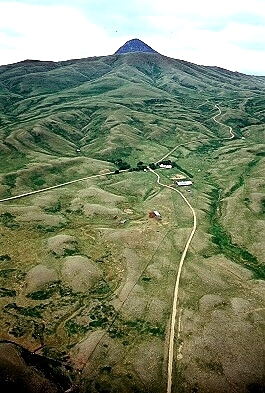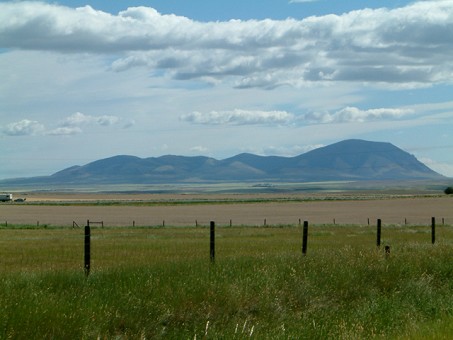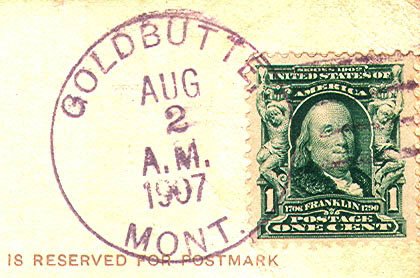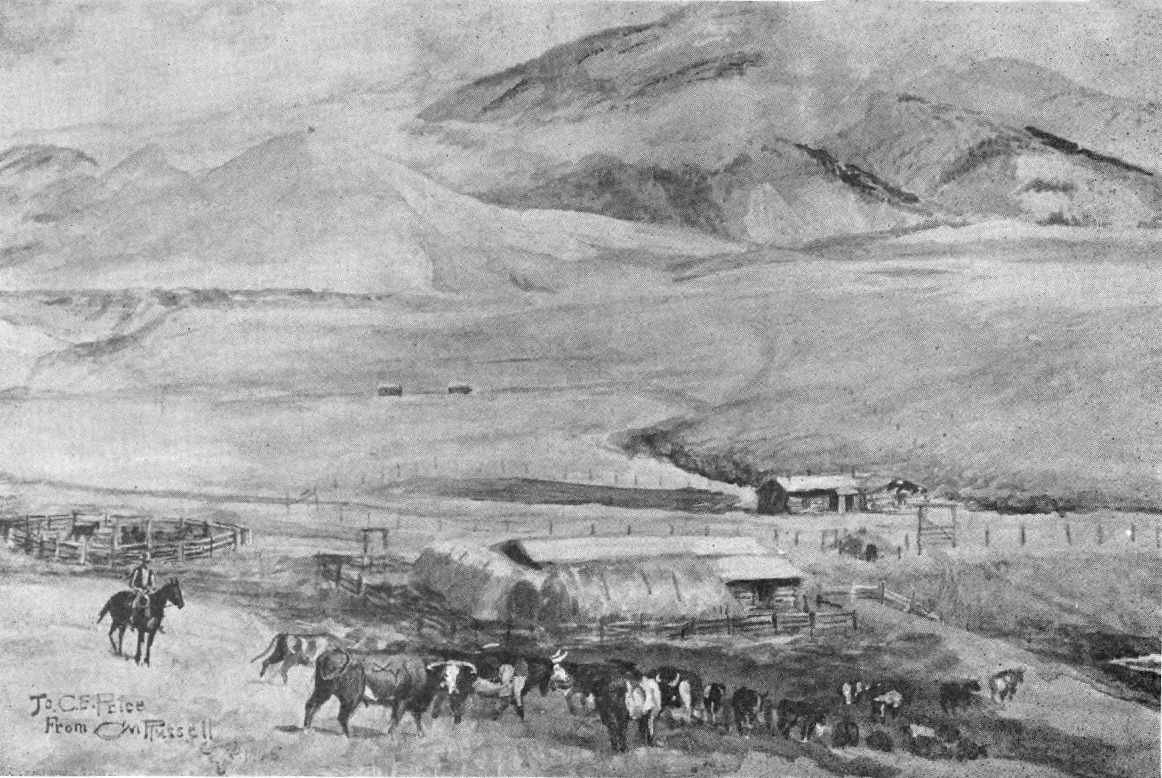A Ghost Town: Gold Butte, MontanaJulia Dafoe & Megan Maki, Chester High School Winding up the dusty road, the warm colors of the sunset greet my
friend and me as we approach the old ghost town. Looking at the coulee,
only a trace of the life that existed is visible. The days when the town
was prosperous are long gone. The dance hall has burned down. The store
has been closed for decades. The school is now Wood’s garage. All the
buildings have been either burned to ashes or bulldozed to the ground. Winding up the dusty road, the warm colors of the sunset greet my
friend and me as we approach the old ghost town. Looking at the coulee,
only a trace of the life that existed is visible. The days when the town
was prosperous are long gone. The dance hall has burned down. The store
has been closed for decades. The school is now Wood’s garage. All the
buildings have been either burned to ashes or bulldozed to the ground.
But memories linger, haunting the ghost town of Gold Butte in the Sweetgrass Hills. Only a few old-timers who were alive to experience Gold Butte still survive to tell us how it was. We try to imagine what this town must have looked like during its
prime. Down past the little pond and the entrance of the mine we walk,
slowing as we approach our destination. Silence cuts through the air
like a knife as we walk up the hill towards the gravestone History is often woven together with the legends, stories, and ghost tales that are common in many communities. Each generation tells them differently and in the shuffle of storytelling, facts and truth get stretched to make the stories sound better or more interesting. Some tales become so distorted and so far from the truth that they are but fables. Why do communities tell such fables? How do stories become so distant from actual history? According to the introduction of Haunted Places: The National Directory, "when unexplainable events occur, interpretation is everything. Each of us tends to explain the unknowable in his or her own way, and therefore [fables] are to some degree a question of individual interpretation." Certainly a young girl’s grave resting along a hillside with a strange inscription has caught the imagination of local residents, leading many people to offer interpretations of what happened. According to legend around the community of Gold Butte and beyond (Whitlash), the "haunted" grave that rests across the coulee from the Gold Butte Cemetery is that of a young prostitute. The story explains that a young prostitute died, like many of the "working girls" with no family nearby. So the other girls tried to give her a decent burial. When the "good" people of Gold Butte’s church heard they were going to bury her in the town’s cemetery, they wouldn’t allow it. So the other girls buried her outside the fence, and had the inscription carved on her headstone to prick the consciences of the "good Christians" who wouldn’t allow a Christian burial for a young girl trying to survive in a man’s world (Bob and Toni Dafoe). But as we probed past the stories, a different story slowly came to light. We recovered the girl’s name. She was Jessie Rowe, born in 1887 and buried at fifteen years of age in 1902. She came to Gold Butte from Kansas with her older sister, Ada, who was under twenty years old. The sisters came to Gold Butte because Jessie had tuberculosis, then known as consumption, a disease that affects the lungs. It was thought that the dry air might help her condition. The two sisters lived with John and Mirty Umphry in the "Lower Grove." Both girls attended Whitlash School. However, Jessie’s condition didn’t improve and eventually she died. She was buried in what then was the Gold Butte Cemetery, which later had to be moved due to an underground spring. This explains why her grave stands alone far from the more recent Gold Butte Cemetery. With a little more detective work, we discovered that in reality her grave is not alone. There are five unmarked graves near her’s. One is that of Miss Naifus, the third Gold Butte schoolteacher (Evelyn Aiken). She died on her wedding day, October 6, 1897, of tubercular disease of the brain, after being sick for only three weeks. She was engaged to James Fenton, the postmaster in Gold Butte and the man who gave Gold Butte its name (Langel, 1118). Another twist to this story is that it was falsely rumored that Jessie Rowe was engaged to Mr. Fenton, but died before they could be married (Evelyn Aiken). Somehow, these two graves and the real stories behind them must have gotten mixed up, and people mistook Miss Naifus for Jessie Rowe. This is a good example of how facts migrate and change from story to story. The mix-up of names, dates, and places is common in rumors that later become legends. Only after careful research does the truth reveal itself. People love gossip, which is maybe why ghost stories, fables, and legends get retold throughout the generations. It takes history lovers and detectives to dig through these fables and figments of gossip to get to the truth. And even though most of these eccentric stories are usually untrue, the eccentricity of it is what lures these history lovers to become determined to uncover the truth. This too is part of historical research: being unable to nail down the facts, and having to rely on plausible theories, while clearly labeling them as such, leaving the way open for future researchers. There are many unmarked graves in the current Gold Butte Cemetery, dating from the time gold was first discovered by Rodney Bames in 1888 until Gold Butte folded during the 1940s. Only death dates are engraved on metal plates, which lie flush with the earth. These graves are most likely those of the miners who came to Gold Butte and died in mining accidents. Of course this is an assumption, not a fact. We visited with longtime residents of the area but most had no idea who these graves belonged to. They agreed with the theory that they belonged to miners. This makes sense because many miners came to find gold and there were minimal safety rules and regulations in the late 1800s. Mining accidents were common and medical care was primitive. We learned that before Rodney Bames discovered gold in Gold Butte, there were cattle. The Hills supported thousands of cattle with enough horses for cowboys to manage the cattle and a few sheep. Before and since the gold boom, the main economy of the Hills has been ranching. The store in Gold Butte catered to the ranchers. In August of 1919, Martin Weidemann, a Great Falls resident, met Tony Fey. Fey was looking for someone to run his store in Gold Butte, and Martin was looking for a job. So after Martin married his sweetheart, Elsie, in his Wisconsin hometown, the two of them rode the train to Chester then rode on the mail wagon to Gold Butte. Their first winter in Gold Butte (1919-1920) was long and hard. In 1920, their first and only child, Norma, was born. She attended grade school in Gold Butte and later attended high school in Shelby. She later married Jim Wood. Tony’s wife ran the motel in Gold Butte. A few old miners who weren’t getting rich and couldn’t afford to leave stayed in the hotel. Mrs. Fey had these people help with hauling in water from the well or wood and coal for heating (Wood). The nearby Gold Butte Saloon had a short life. Residents complained that it was too close to the school, so the school board ordered it to move to another area (Everetts to Hofer, 3). Supplies came into the Hills from the railroad in Chester. About the only time ranchers left were for cattle drives to town. Women went on these drives to cook and buy supplies as well as to see other women. Though ranchers in the Hills didn’t leave often, mail arrived every day but Sunday. The post office played an important role in the lives of the ranchers. Often letters were their only communication with the outside world. Nettie Stott was postmistress from March 3, 1918 through October 1, 1928 (Stott, 50). A large two-story building held the store, the post office, and the Stott family’s home. Louisa Allen Anderson, a daughter of Nettie Stott, was postmistress from October 1, 1928 through August 1, 1974 (Heritage, 50). The post office was later moved to a separate building in Whitlash. Karen Kultgen is the current postmistress, and oddly, with greater technological improvements, the mail now arrives in Whitlash only three times a week. Of course, mail isn’t the only communication to the outside world anymore: roads have improved, people travel to town more frequently, ranchers use computers and e-mail, and telephones and television have greatly reduced the isolation.
Claude’s family worked on the Strode ranch until the Demarest’s settled on a ranch of their own (Strode was the founder of the Whitlash townsite). Even after the Demarest’s settled their own claim, Claude still helped Strode ship calves to Chester every year. Claude told us a story about Strode. "Strode had a hired man named Harrison Moore. Moore was an old man without a family who needed a job during the last ten years of his life; Moore was as blind as a bat. Still, Moore remained on with Strode, as the two became good friends. Strode liked sheep and cattle both, and he switched from cattle to sheep several times. It was always at the wrong times too, and because of that the only time Strode got out of debt was about a year after he passed away. I remember the time we [Strode and Demarest] loaded his cattle onto railroad cars; he looked me straight in the eyes and said, ‘When these cattle reach South Saint Paul, I won’t owe nobody a dollar’"(Demarest). As we examined the past, we were struck by the number of eccentric people we discovered. The names and stories of the same eccentric individuals of long ago reappeared in several interviews. Mr. Holley, who ranched near Whitlash was one such person. According to Earl Thompson who now owns Holley’s ranch, Holley was more than eccentric, he was down-right reckless when it came to driving his car. "Old Man Holley," as he was known around Whitlash, was famous for his driving. "Ben Odegard was telling me about when he used to work for Old Man Holley when he was sixteen or so. He said that one time he and Old Man Holley were coming back from a trip to Chester and were pulling into the garage when Holley hollered ‘Whoa’ just like he was driving a team of horses! Of course, the car didn’t stop. He missed the brake, hit the gas pedal, and they shot clear through the other side of the garage into a clump of willows." Thompson added that the car remained in those willows all summer long. Thompson also told of a visit by his father, Robert, to Old Man Holley. Robert entered the yard just in time to notice that two of Holley’s dogs were fighting. Holley grabbed one of the dogs by the tail and swung it around and around his head. Then he let go of the dog and it flew and hit Robert squarely in the chest, knocking him over (Earl Thompson). Lloyd Oswood was another eccentric character. Longtime Whitlash rancher Claude Demarest told of one incident while working with Oswood. "Lloyd was a clean man, but kind of a slow thinker. One afternoon while we were on our lunch break, I decided to play a practical joke on Lloyd. It was a really hot afternoon and Lloyd must have thought so because he unlaced his tall cowboy boots and pulled off his socks to let them air out. He laid them by the haystack we were leaning against, so I just took one of them and hid it. After he started to put on his socks and boots again, he realized that he was one sock short. He must have torn up that whole stack of hay looking for that lost sock. I told him that he put both socks on one foot, so while he was unlacing the boot with the sock, I carefully placed the other sock beside him. Lloyd thought that he’d missed the sock in the search and was quite dumbfounded. He never figured out that I’d played a trick on him" (Claude Demarest). In the 1960s Whitlash hired a new teacher, Mrs. White. She arrived with her husband and their three girls. "Teachers were hard to hire then and the school was lucky to even get more than one application," said Earl Thompson, who was chairman of the Whitlash School Board at the time. But eerie incidents began to occur after the Whites arrived. The husband occasionally wore a black patch over one eye. Large quantities of White King Soap Boxes, twenty-five pound potato sacks, and cases of pop were stacked to the ceiling of White’s basement. When Thompson asked about them, White replied; "Yep, I’m layin’ in a few supplies." One crazy incident happened after another, until one day White was caught holding up a truck driver. White tried to steal the truck and all its cargo but he couldn’t figure out how to drive it. He was hauled away to jail. After that incident, the White family moved and rumors circulated that White was put into an insane asylum (Earl Thompson Interview). Paul Newman, a schoolteacher in Whitlash sometime in the 1960s, was unusual in a different way. He had a kind heart, a friendly nature and was blind. The people in the Whitlash and surrounding area gathered in Galata one evening where Newman was to accept an award for the Whitlash School for hiring a handicapped teacher. After the dinner, a film was shown to the audience. When the film started, Earl Thompson said he heard what sounded like "Russian." Thompson was sitting next to Newman, and Newman commented, "They have the film in backwards." A bit later, the rest of the audience saw people in the film walk down steps backwards and then watched planes landing backwards. Finally the audience caught up with him. As they realized what he was talking about, they began to chuckle. (Thompson interview). "A community that does not have old people and children, white-collar and blue-collar, eccentric and conventional, and so on, is not a community at all, but the same kind of truncated and deformed monstrosity that most people inhabit today" (Annual Editions: Readings in Psychology, 295-296). Whether people are true examples of kindheartedness like Newman, just plain crazy like White, or true cowboys like Holley, Demarest, and Strode, they all play a significant role in our sense of community. We find places for them. Many of the old-timers who first settled the areas of Gold Butte and Whitlash have long since passed away, leaving only a few stories of the past with relatives. It is important for their stories to be written down and preserved for future generations. By learning about our past, we can learn about what hardships these pioneers went through and what little technology and luxuries they had. That way, we can be more appreciative towards the settlers who paved the roads we travel upon without a thought. Many of these settlers were eccentric, people who stood out from the crowd. Maybe our generation needs to learn to stand out from the crowd and become leaders in our own way, so that we too can become the settlers who will pave the road for the next generation.
Works Cited Aiken, Evelyn; Personal Interview 8 Feb. 1998. Conducted in the Anderson household. Anderson, Louisa; Personal Interview 8 Feb. 1998. Conducted in the Anderson household. Anderson, Louisa; "Louisa Stott Allen Anderson," Our Heritage in Liberty County; Ed. Liberty County Museum Chester: Liberty County Times, 1976. 60-62. Anderson, Louisa. "Lester A. and Nettie Alvord Stott." Our Heritage in Liberty County. Ed. Liberty County Museum. Chester: Liberty County Times, 1976. 40-41. Annual Editions: Readings in Psychology 1974-1975; The Dushkin Publishing Group, Inc. (Sluice Dock Guilford, CT., 1974) Brown, Elmer "Irvin;" Personal Interview 31 Jan. 1998. Conducted in the Dafoe household. Demarest, Claude; Personal Interview 25 Jan. 1998. Conducted in the Thompson household. Copy of notes in the personal library of Julia Dafoe. Demarest, Marty; Everetts to Hofer; ts. Liberty County Museum, Chester. "Harry and Amelia Demarest;" Our Heritage in Liberty County; Ed. Liberty County Museum. Chester: Liberty County Times, 1976. 50-52. Hauck, Dennis William; Haunted Places: The National Directory (Penguin Books: New York, New York, 1996) "John Brown," Our Heritage in Liberty County; Ed. Liberty County Museum. Chester: Liberty County Times, 1976. 62-63. Langel, Ruby; Chester Country: A Century of Changes (n.p. 1994. Collection of newspaper articles compiled from newspapers around Montana from the years 1713-1993) |
Photos added by Karen 11 Oct 2018
Text from: http://www.montanaheritageproject.org/edheritage/HE_01win/pages/dafoe.htm
 surrounded by
a metal bar, rusted by spring rains and harsh winter snows. We squint to
read the inscription in the slant sunlight: "Remember me as you
pass by, as you are now so once was I, as I am now so soon shall you be,
prepare for death and follow me." A fifteen-year-old girl lies
buried outside the cemetery, with a haunting inscription on the rough
surface of the gray, lifeless stone. What is the story? My friend and I
leave the grave determined to track it down.
surrounded by
a metal bar, rusted by spring rains and harsh winter snows. We squint to
read the inscription in the slant sunlight: "Remember me as you
pass by, as you are now so once was I, as I am now so soon shall you be,
prepare for death and follow me." A fifteen-year-old girl lies
buried outside the cemetery, with a haunting inscription on the rough
surface of the gray, lifeless stone. What is the story? My friend and I
leave the grave determined to track it down. Other things have changed, too. True cowboys, the ones who are every
young child’s hero, are rather hard to find. A lot of "dime store
cowboys" are around, but the real cowboys are rare. Visiting with
these true cowboys is the only way that their way of life can be
preserved and documented. Claude Demarest is one of those true cowboys.
Grizzled, wrinkled, and honest, Claude shows every indication of what it
was like to be a hard working rancher all of his life.
Other things have changed, too. True cowboys, the ones who are every
young child’s hero, are rather hard to find. A lot of "dime store
cowboys" are around, but the real cowboys are rare. Visiting with
these true cowboys is the only way that their way of life can be
preserved and documented. Claude Demarest is one of those true cowboys.
Grizzled, wrinkled, and honest, Claude shows every indication of what it
was like to be a hard working rancher all of his life.